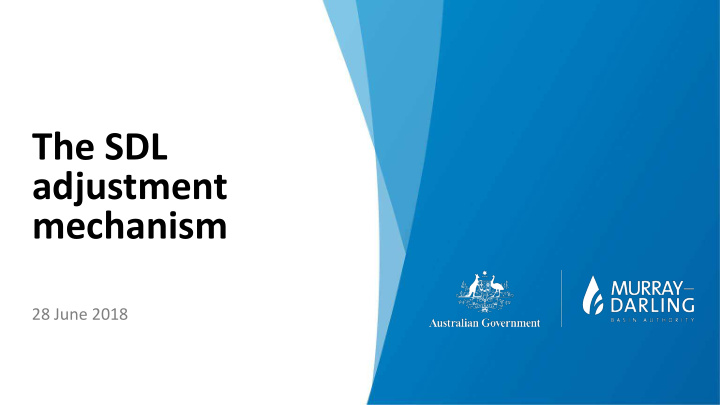



The SDL adjustment mechanism 28 June 2018
Outline of presentation What is the SDL adjustment • mechanism? • Phased assessment process • Operation of the mechanism • Reconciliation
The SDL adjustment mechanism • Basin Plan is flexible and adaptive • Included to improve both socio-economic and environmental outcomes • Adjustment up or down by 5 per cent (approx. 543 GL). Basin states DAWR MDBA Commonwealth Minister Federal Parliament Technical analysis of projects, Provides project funding, Reviews MDBA determines adjustment amount, Propose and deliver projects, assesses projects, recommendation and makes recommendation to Allow/disallow legislation assesses each other’s projects implementation of the efficiency introduces legislation to Commonwealth Minister, monitors measure program Parliament as law progress, reconciliation decision
4 SDL adjustment mechanism
5 Timing for the SDL adjustment mechanism
Operation of the mechanism Basin Plan scenario in the model (2750 GL water recovery) Add package of supply projects Run supply package modelling scenario Check ecology scores Reduce water recovery Check limits of change Check reliability of supply metrics Final adjustment volume PPMs must be in place by 30 June 2019
Next steps • The Sustainable Diversion Limit (SDL) adjustment mechanism amendment was given to the previous Commonwealth Minister responsible for water on 8 December 2017 and became law on 13 January 2018. • From here, states will further refine and develop the supply projects, working with their communities. Some, e.g. The Living Murray projects are already in operation. • The Basin Plan provides the MDBA with the option to undertake a reconciliation of the 2017 SDL adjustment in 2024 if it considers this necessary. • Reconciliation tests if the package of supply projects, as implemented in 2024, has delivered the expected environmental outcomes. To make this decision, the MDBA will continue to play a key role in monitoring the integrity of the operation of • the adjustment mechanism and will use an adaptive management approach running from 2018 through to 2024.
Reconciliation • Many of the supply projects have important issues and risks to be resolved during the implementation phase from 2018–2024. • It is clear that most projects will evolve and change, through concept trials, community and stakeholder input, and interactions between projects as they develop. • The MDBA acknowledges that some projects may not deliver the full environmental benefits expected, and other projects may improve and deliver greater environmental benefits, as refinements are made through learning and adaptation.
Adaptive management approach • The MDBA will evaluate, verify and publically report on project implementation progress to serve three purposes: • to provide the transparency and credibility needed for stakeholders and the community to have confidence in the supply projects delivering the expected environmental outcomes • to provide a level of accountability for project implementation across all state proponents • to best identify, manage and minimise risks associated with delivering project outcomes. • The approach will include an annual evaluation of each project by the MDBA, using the best available evidence to assess progress made toward the delivery of expected environmental outcomes. • The MDBA must be confident that any project changes will still deliver environmental outcomes consistent with the 2017 determination. • The MDBA will undertake a formal reconciliation if reporting, through the adaptive management framework, indicates that this is not the case, using the method agreed by all Basin governments.
Thank you. Office locations Office locations Adelaide Adelaide Albury-Wodonga Albury-Wodonga Canberra Canberra Toowoomba Toowoomba mdba.gov.au mdba.gov.au 1800 630 114 1800 630 114 engagement@mdba.gov.au engagement@mdba.gov.au
Recommend
More recommend